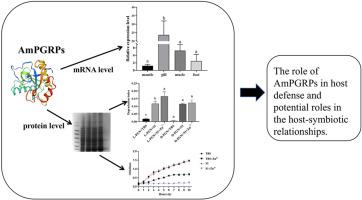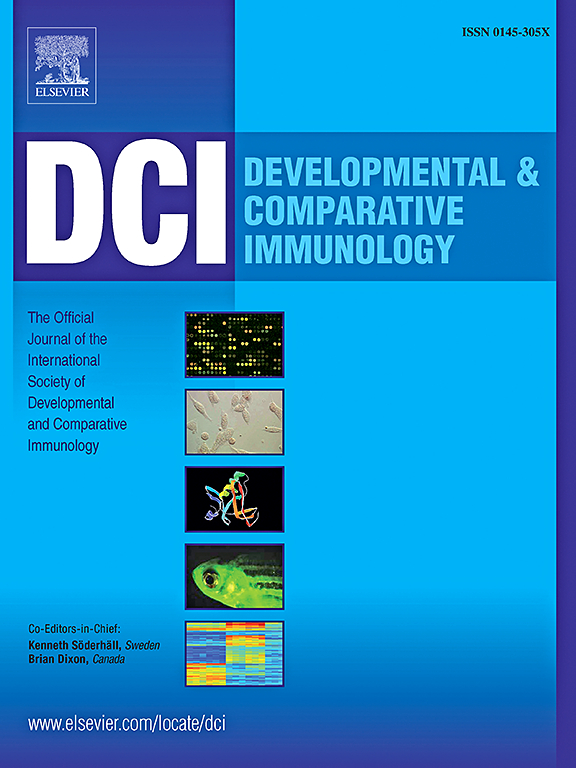蛤蚧短肽聚糖识别蛋白的分子和功能特征。
IF 2.7
3区 农林科学
Q1 FISHERIES
引用次数: 0
摘要
在寒冷的渗漏环境中,Vesicomyidae 蛤蜊是一种常见的物种,它与寄生在其鳃器官中的微生物之间的共生关系使其与众不同。鉴于这种共生关系的极端条件和共生性质,研究宿主的免疫基因,特别是免疫识别受体,对于了解它们在促进宿主-共生相互作用中的作用至关重要。在蛤蜊中发现了三种短的肽聚糖识别蛋白(PGRPs)。发现AmPGRP-S1、-S2和-S3具有保守的酰胺酶结合位点和Zn2+结合位点。定量实时 PCR(qRT-PCR)分析显示了 PGRPs 的不同表达模式。AmPGRP-S1和AmPGRP-S2在鳃中的表达水平较高,而AmPGRP-S3在内收肌中的表达水平最高。功能实验表明,重组 AmPGRP-S1、-S2 和 -S3(rAmPGRPs)具有与 L-PGN 和 D-PGN(肽聚糖)结合的能力。值得注意的是,rAmPGRP-S1 和 -S2 具有不依赖 Zn2+ 的酰胺酶活性,而 rAmPGRP-S3 则缺乏这种酶功能。其中,rAmPGRP-S1 可抑制大肠杆菌和枯草杆菌,而 rAmPGRP-S2 和 -S3 则可在无 Zn2+ 的情况下抑制枯草杆菌。在有 Zn2+ 的情况下,rAmPGRP-S1 和 -S2 对金黄色葡萄球菌或枯草杆菌的抑制活性增强。这些研究结果表明,AmPGRPs 在介导宿主与内共生细菌之间的相互作用方面可能起着关键作用,可作为 PGN 和微生物受体、抗菌效应器以及宿主-微生物共生的调节器发挥作用。这些结果有助于我们了解深海生物对具有挑战性的冷渗漏环境的适应机制。本文章由计算机程序翻译,如有差异,请以英文原文为准。

Molecular and functional characterization of short peptidoglycan recognition proteins in Vesicomyidae clam
Within cold seep environments, the Vesicomyidae clam emerges as a prevalent species, distinguished by its symbiotic relationship with microorganisms housed within its organ gill. Given the extreme conditions and the symbiotic nature of this association, investigating the host's immune genes, particularly immune recognition receptors, is essential for understanding their role in facilitating host-symbiotic interactions. Three short peptidoglycan recognition proteins (PGRPs) were identified in the clam. AmPGRP-S1, -S2, and -S3 were found to possess conserved amidase binding sites and Zn2+ binding sites. Quantitative Real-time PCR (qRT-PCR) analysis revealed differential expression patterns among the PGRPs. AmPGRP-S1 and AmPGRP-S2 exhibited elevated expression levels in the gill, while AmPGRP-S3 displayed the highest expression in the adductor muscle. Functional experiments demonstrated that recombinant AmPGRP-S1, -S2, and -S3 (rAmPGRPs) exhibited binding capabilities to both L-PGN and D-PGN (peptidoglycan). Notably, rAmPGRP-S1 and -S2 possessed Zn2+-independent amidase activity, while rAmPGRP-S3 lacked this enzymatic function. rAmPGRPs were shown to bind to five different bacterial species. Among these, rAmPGRP-S1 inhibited Escherichia coli and Bacillus subtilis, while rAmPGRP-S2 and -S3 inhibited Bacillus subtilis in the absence of Zn2+. In the presence of Zn2+, rAmPGRP-S1 and -S2 exhibited enhanced inhibitory activity against Staphylococcus aureus or Bacillus subtilis. These findings suggest that AmPGRPs may play a pivotal role in mediating the interaction between the host and endosymbiotic bacteria, functioning as PGN and microbe receptors, antibacterial effectors, and regulators of host-microbe symbiosis. These results contribute to our understanding of the adaptive mechanisms of deep-sea organisms to the challenging cold seep environments.
求助全文
通过发布文献求助,成功后即可免费获取论文全文。
去求助
来源期刊
CiteScore
6.20
自引率
6.90%
发文量
206
审稿时长
49 days
期刊介绍:
Developmental and Comparative Immunology (DCI) is an international journal that publishes articles describing original research in all areas of immunology, including comparative aspects of immunity and the evolution and development of the immune system. Manuscripts describing studies of immune systems in both vertebrates and invertebrates are welcome. All levels of immunological investigations are appropriate: organismal, cellular, biochemical and molecular genetics, extending to such fields as aging of the immune system, interaction between the immune and neuroendocrine system and intestinal immunity.

 求助内容:
求助内容: 应助结果提醒方式:
应助结果提醒方式:


